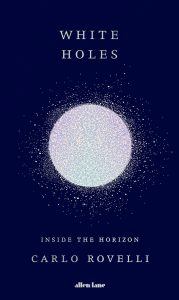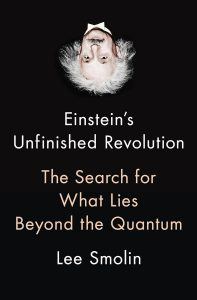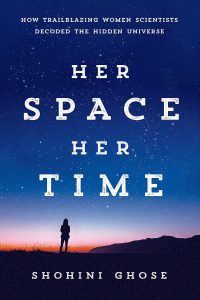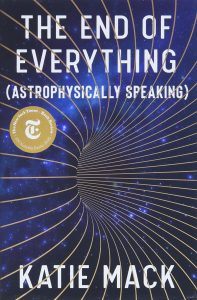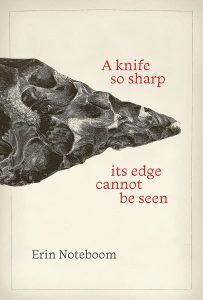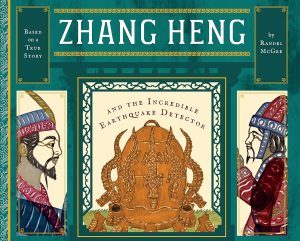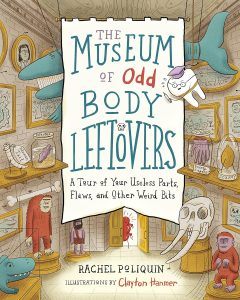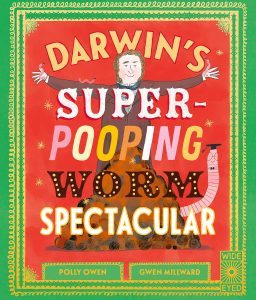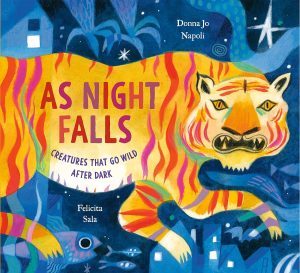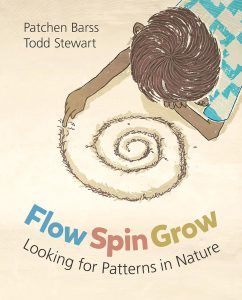What do you give to loved ones who have their heads in the stars, in the deepest depths of the particles of nature, or in the great outdoors?
A spacetime portal, of course!
You can find spacetime portals on the shelves of your local bookstore. As children’s author Dr. Seuss said: “The more that you read, the more things you will know. The more that you learn, the more places you’ll go.”
Here are 11 books – 6 for adults and 5 for children – that will take your loved ones on new adventures in 2024, just in time for the holidays!
Books for adults
White Holes: Inside the Horizon by Carlo Rovelli (Riverhead Books, 2023)
Carlo Rovelli is an Italian theoretical physicist who is also a lyrical and gifted writer.
Anyone who has read any of his previous books – including Seven Brief Lessons on Physics (2014), The Order of Time (2017), and Helgoland: Making Sense of the Quantum Revolution (2021) – will know that his poetic prose makes theoretical physics accessible to everyone.
As an accomplished scientist, he has worked on loop quantum gravity and introduced concepts such as the relational interpretation of quantum mechanics, the view that everything exists only in relation to other things. He holds a Distinguished Visiting Research Chair at Perimeter and is also a core member of the Rotman Institute of Philosophy at Western University.
His latest popular book is White Holes: Inside the Horizon.
This portal takes us on a mesmerizing journey into the strange world of black holes by examining their theoretical counterpart: white holes.
Rovelli takes you past the event horizon and into the black hole’s throat. Some physicists think this is where spacetime should end. But Rovelli says, “I have in mind a flight plan. We get to the edge of the horizon, we enter, go down, till the very bottom, cross it, and break through like Alice Through the Looking Glass to emerge on the other side in a white hole.”
Einstein’s Unfinished Revolution: The Search for What Lies Beyond the Quantum by Lee Smolin (Penguin Press, 2019)
Speaking of Perimeter authors, our well-known faculty member Lee Smolin’s sixth book, Einstein’s Unfinished Revolution: The Search for What Lies Beyond the Quantum, is a thought-provoking option.
Smolin argues that quantum theory is incomplete. “I have been on Einstein’s side in the search for a deeper but simpler reality behind quantum mechanics since first reading him on the subject as a high school dropout,” Smolin says in the first chapter of this book.
If you are looking for a portal into the fantastic quantum world that also embraces common sense realism, there is no better guide than Smolin.
On the Origin of Time: Stephen Hawking’s Final Theory by Thomas Hertog (Random House, 2023)
Stephen Hawking was an incredible supporter of Perimeter Institute and our inaugural Distinguished Visiting Research Chair. Starting in the 1990s and up until his death in 2018, he was consumed with the question of why the universe is so finely tuned to life.
If the laws of gravity, electromagnetism, and nuclear forces had been only slightly different, life would not exist. But why? Is this a coincidence? Was it because nature had no choice? Are we part of a multiverse, just one among countless others, so it appears to us that we are special, but we are not?
Thomas Hertog, a Belgian cosmologist at KU Leuven, was one of Hawking’s closest collaborators and this book is a portal into Hawking’s thoughts on this subject, his final (unfinished) theory.
Her Space, Her Time: How Trailblazing Women Scientists Decoded the Hidden Universe by Shohini Ghose (Random House, 2023)
Shohini Ghose is another local author and scientist, a professor of physics and computer science at Wilfrid Laurier University, director of the Laurier Centre for Women in Science (WinS), and a Perimeter affiliate. She is also the Chair for Women in Science and Engineering from the Natural Sciences and Engineering Council of Canada.
Her latest book, Her Space, Her Time, shares the stories of women in physics and astronomy from the 19th century to the present. Women such as Henrietta Leavitt, Margaret Burbidge, Vera Rubin, and the women of the Manhattan Project revolutionized physics and astronomy, yet most of us grew up knowing so little about them.
Ghose is a wonderful writer, and this book is a portal into the lives of women who were too often hidden in the dusty book bins of science history, but who nevertheless changed our understanding of the universe.
The End of Everything (Astrophysically Speaking) by Katie Mack (Scribner, 2020)
Theoretical astrophysicist Katie Mack is an elegant writer and science communicator with a prolific following on social media. She holds the Hawking Chair in Cosmology and Science Communication at Perimeter, where she hosted the popular Quantum 101 series and has been featured in Conversations at the Perimeter and in our public lecture series.
Mack carries out research on dark matter and the early universe and works to make physics more accessible to the general public. Her popular 2020 book, The End of Everything (Astrophysically Speaking), is a portal into the distant future of our universe and the end of all things.
Will it end in a Big Crunch? Will it just keep expanding and fade away in what is known as the “heat death?” Or will the Big Rip tear apart the very fabric of reality?
Sure, given climate change and so many other potential near-term catastrophes, the end of the universe may seem very far down on the list of existential threats. But this cosmological journey gives us the big perspective on our place in this vast and fascinating universe.
A knife so sharp its edge cannot be seen by Erin Noteboom (Brick Books, 2023)
This soulful book of poetry at the intersection of art and science is a portal into the places where love and loss are experienced through the triumphs and failures of science. Poet Erin Noteboom may be better known to those who follow Perimeter as Erin Bow, one of the Institute’s science writers and also an award-winning young adult fiction author.
In this collection, we meet historical characters such as Wilhelm Röntgen, who discovered X-rays and used them to make an image of his wife’s hand and wedding ring; Marie Curie, who did pioneering work on radioactivity and died at age 66, likely from long-term exposure to radiation; and Abu Ali al Hasan ibn al-Haytham, a 10th-century philosopher and physicist who wrote his great Book of Optics while under house arrest.
The lyric poem is a tool for scientific and emotional exploration in this book that Quill & Quire describes as “a slow burn of simmering wisdom.”
Books for children
Zhang Heng and the Incredible Earthquake Detector by Randel McGee (Familius, 2022; Ages 4-8)
This picture book by Randel McGee, who is also a puppeteer and paper-cut artist, was selected by the National Science Teaching Association in the United States as one of the Best STEM Books of 2022 for children K-12.
The story transports children to the wondrous landscapes of pre-modern China. There, in ancient times, people thought earthquakes were caused by dragons stirring beneath their feet. But in an empire so vast, it was hard to know when and where an earthquake had happened, so it was hard to dispatch help in time.
Emperor Shun Di assigns Zhang Heng to create a device that will give him this important information. In this inspirational book based on a true story, the protagonist overcomes the jealousy of palace courtiers and invents the first true seismoscope.
Randel McGee has long studied shadow puppetry and his illustrations in this book draw from that ancient Chinese art-form. You can listen to a reading here.
The Museum of Odd Body Leftovers: A Tour of Your Useless Parts, Flaws, and Other Weird Bits by Rachel Poliquin, author, and Clayton Hanmer, illustrator (Greystone Kids, 2022, Ages 7-11)
This book was the Science Writers and Communicators of Canada best children’s science book pick and Paradigm Prize award winner in the children’s book category in 2022. It is funny and playful, leading readers through a museum dedicated to vestigial body parts that are leftovers from our ancient evolutionary ancestors, and also explains weird body reactions like goosebumps and hiccups.
Darwin’s Super-Pooping Worm Spectacular, by Polly Owen, author, and Gwen Millward, illustrator (Wide Eyed Editions, 2023, Ages 6-8)
This book was featured on Science Friday and would delight the sort of kid who likes to dig in the dirt.
It is based on the true story about how Charles Darwin came to realize that the earthworm was the most important species on our planet, and the funny experiments that led him to discover this humble creature’s greatest superpower: Poop!
It was lauded by BBC Wildlife as “a disarmingly silly read that manages to share cool worm science with a light and easy touch.”
As Night Falls: Creatures That Go Wild After Dark, by Donna Jo Napoli, author, and Felicita Sala, illustrator (Random House Studio, 2023, Ages 4-8 years)
This book was one of 10 winners of The New York Times/New York Public Library Best Illustrated Children’s Books Award. Publishers Weekly gave it a starred review, saying that “in a clever concluding twist, the narrative comes full circle, proposing a way that little insomniacs might tame their own inner fierceness at bedtime.”
It is a bedtime story for children who are interested in wild animals that go berserk at night.
Flow Spin Grow: Looking for Patterns in Nature by Patchen Barss, author, and Todd Stewart, illustrator (Owlkids, 2018, Ages 4-8)
Patchen Barss is a Perimeter science writer, as well as author of both adult and children’s science books.
Flow Spin Grow: Looking for Patterns in Nature is a book that inspires children to become scientists. It introduces them to patterns in nature, from the galaxies in the cosmos to the patterns on the earth: the branches of a tree reaching into the sky, to its roots digging deep in the ground; from storms and snail shells to the lungs and veins deep in our bodies.
In 2019, it was listed as one of the Outstanding Science Trade Books for Students K-12 by the National Science Teachers Association.
Quill & Quire says it “aims not to lead but inspire children to make their own discoveries, to be their own scientists.”
About PI
Perimeter Institute is the world’s largest research hub devoted to theoretical physics. The independent Institute was founded in 1999 to foster breakthroughs in the fundamental understanding of our universe, from the smallest particles to the entire cosmos. Research at Perimeter is motivated by the understanding that fundamental science advances human knowledge and catalyzes innovation, and that today’s theoretical physics is tomorrow’s technology. Located in the Region of Waterloo, the not-for-profit Institute is a unique public-private endeavour, including the Governments of Ontario and Canada, that enables cutting-edge research, trains the next generation of scientific pioneers, and shares the power of physics through award-winning educational outreach and public engagement.
You might be interested in




